What Do Termite Droppings Look Like?
Termite droppings vary in appearance depending on the species of termites.
There are three common forms they can take: Pellets, Mud tubes, and Patches.
Termite Pellets or Frass
Pellets, a.k.a frass, are hexagonal, egg-shaped granules.
They look like sand or coffee ground and feel a little rough if stepped on.
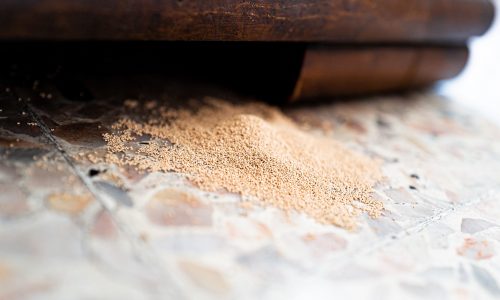
Mud Tubes
A mud tube is made of termite droppings, soil, saliva, and wood.
These tubes help protect termites when traveling between food and the nest.
These mud tunnels take on different forms: working tube, exploratory tube and drop tubes.
Working tube and exploratory tube look like veins running up against your wall.
Drop tubes look like calcium deposits that hang in caves. Except they hang from the ceiling.
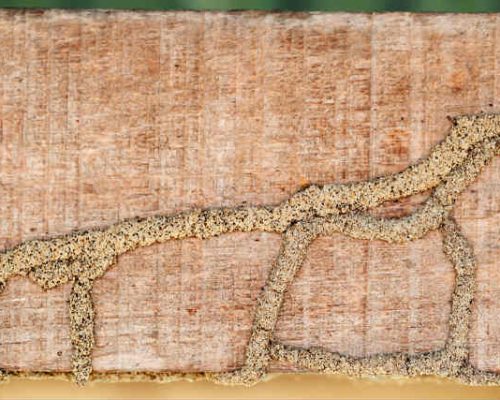
Patches or Seals
Seals look like a paste.
Termites use them to seal entry points around their nest.
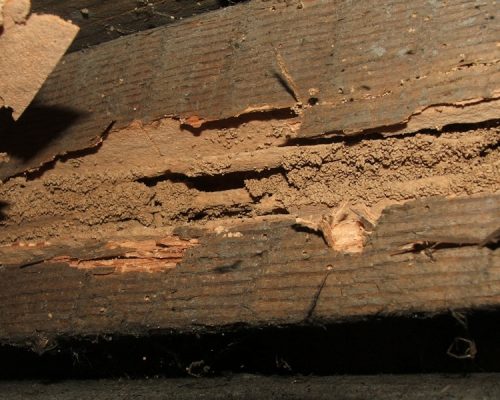
What does Drywood Termite Frass Look Like?
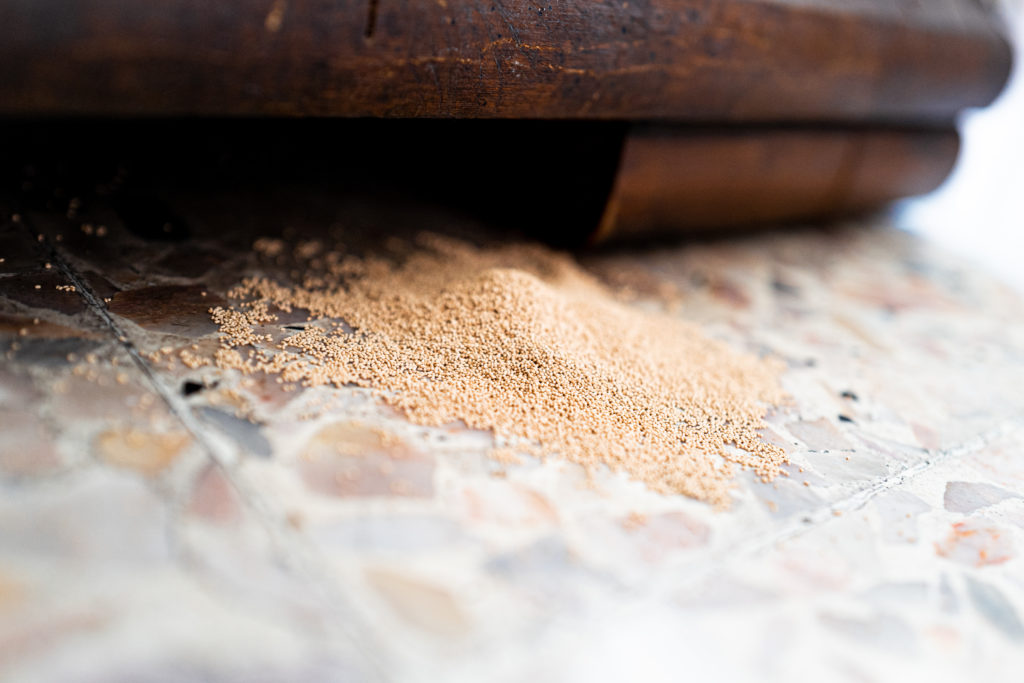
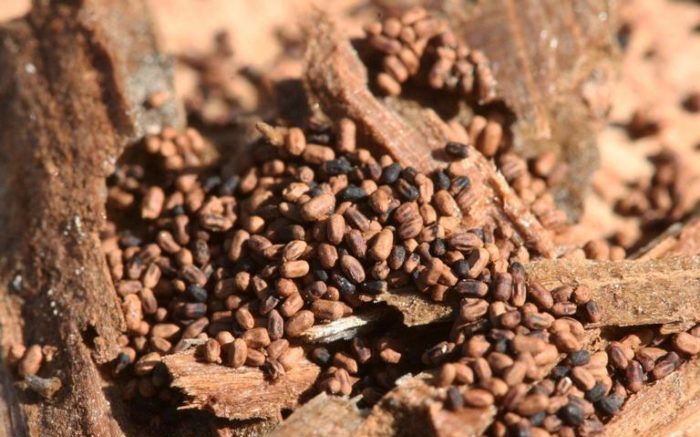
Drywood termites live inside wood.
They produce small, dry droppings called pellets or frass.
Drywood termite pellets look a lot like sand or sawdust.
But unlike sand, a drywood pellet has six concave surfaces.
They are hard, elongated, and less than 1/25 inch long.
Drywood frass can be different colors, depending on the color of the wood termites have been eating.
You may find traces of pellets into their feeding tunnel.
But, in most cases, Drywood termites use “kick out” holes to remove pellets from their tunnels (See image below).
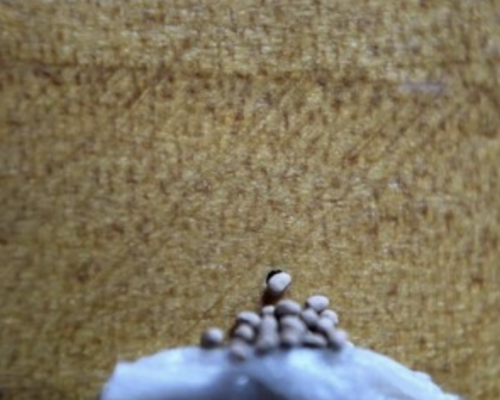
If you have an infestation, you may find small piles of dry wood termite pellets on doors, widows, floorboards and under your furniture.
You may also find them around eaves and joints inside attics and basements.
If you have wooded patios or decks, check the base and corners for any signs of termite droppings.
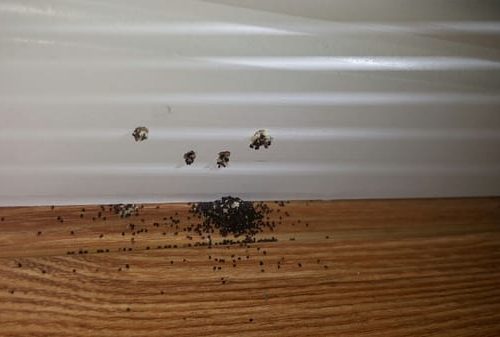
What Does Dampwood Termite Frass Look Like?
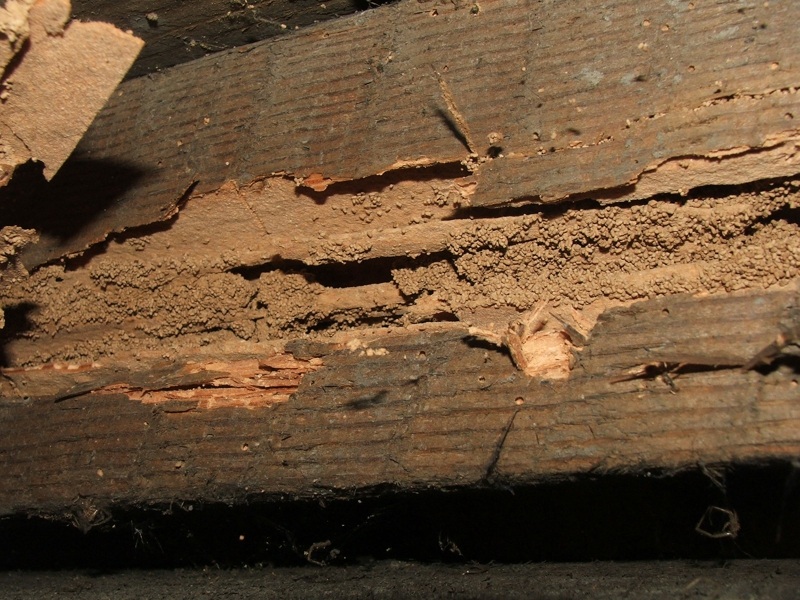
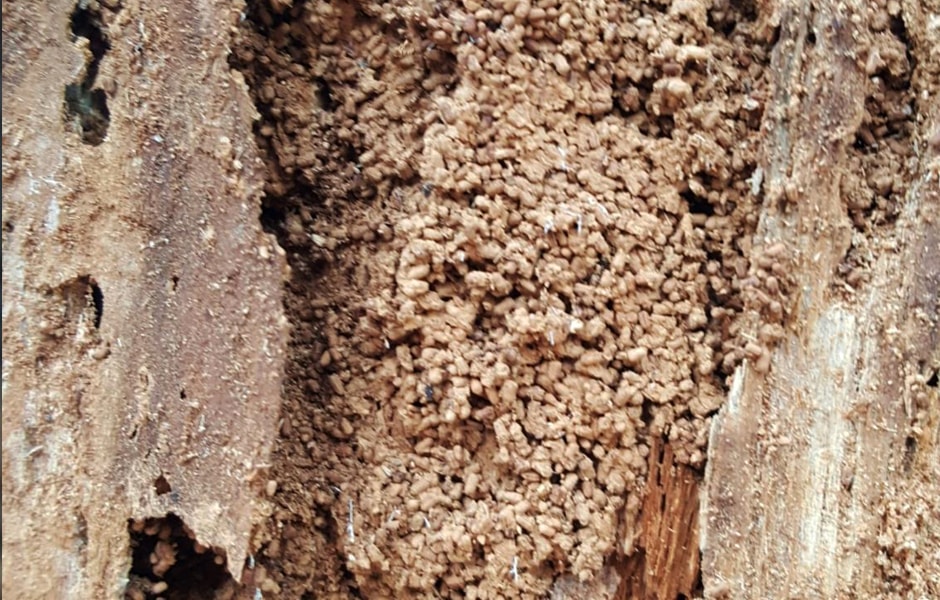
The Dampwood termite infest damp and decaying timber.
They use their fecal pellets to protect their home.
Their fecal pellets are about 1/32″ long.
The color varies depending on the wood the termites are eating.
Damp wood pellets have a long, oval shape with six flat sides.
If the wood they’re consuming is very damp, the pellets may come out round.
Unlike Drywood termites, Dampwood termites do not expel their pellets into a “kick out” holes.
Instead, they use their pellets to seal their entry points from the outside world.
As a result, it is challenging to find damp wood termites pellets lying around.
Sometimes, the pellets may fall through. But that typically only happens if the wood they are eating is not damp enough.
The easiest way you’ll find Dampwood pellets is on damaged wood.
The damaged wood will typically have holes with a cover that looks like soft concrete.
It could be easy to spot this because the coverage is often imperfect.
You’ll most likely see Dampwood termites and pellets near water or moist areas.
Some familiar places they’ll invest in your home is your basement, shed, deck, porch, and outdoor furniture.
You may also find them under sinks, tubs, or near water hoses.
What Does Subterranean Termite Droppings Look Like?
Subterranean termites live in the ground.
They generally do not leave visible droppings behind.
That is because they use their droppings to construct tunnels and mud tubes.
Mud tubes help Subterranean termites to travel safely
between a food source and the nest.
These tubes are made of termite feces, saliva, and dirt.
Typically, mud tubes are the first indication of Subterranean termites infestation.
You’ll typically find these tubes on or near the soil.
You may find them near your pipes, in your attic, crawlspace, or along your foundation.
Mud tubes typically take on three forms: working tube, exploratory tube, and drop tube.
Working tube
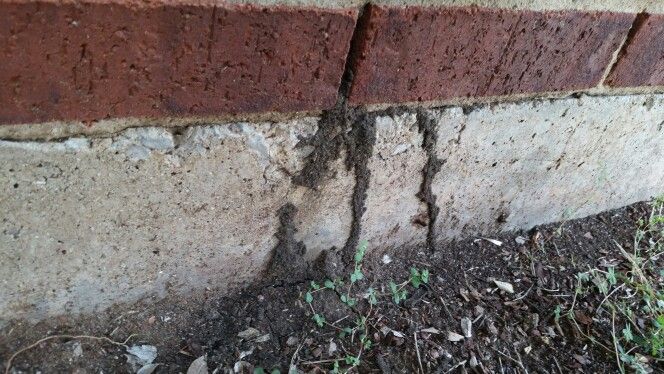
Termites use the working tube to travel from their nests to food sources.
These mud tunnels look like veins running up against your wall.
They work similarly to highways.
The termites use some lanes to carry food and others for construction and repair.
Exploratory tube
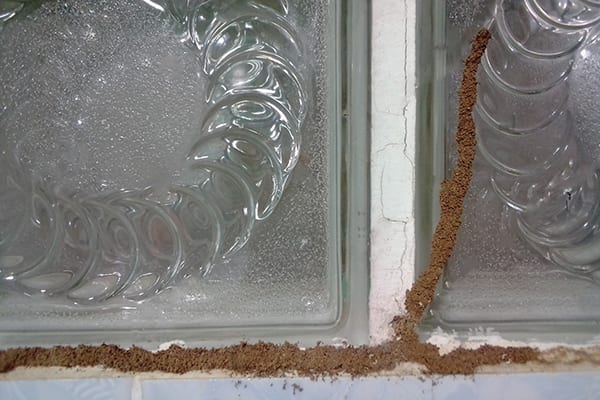
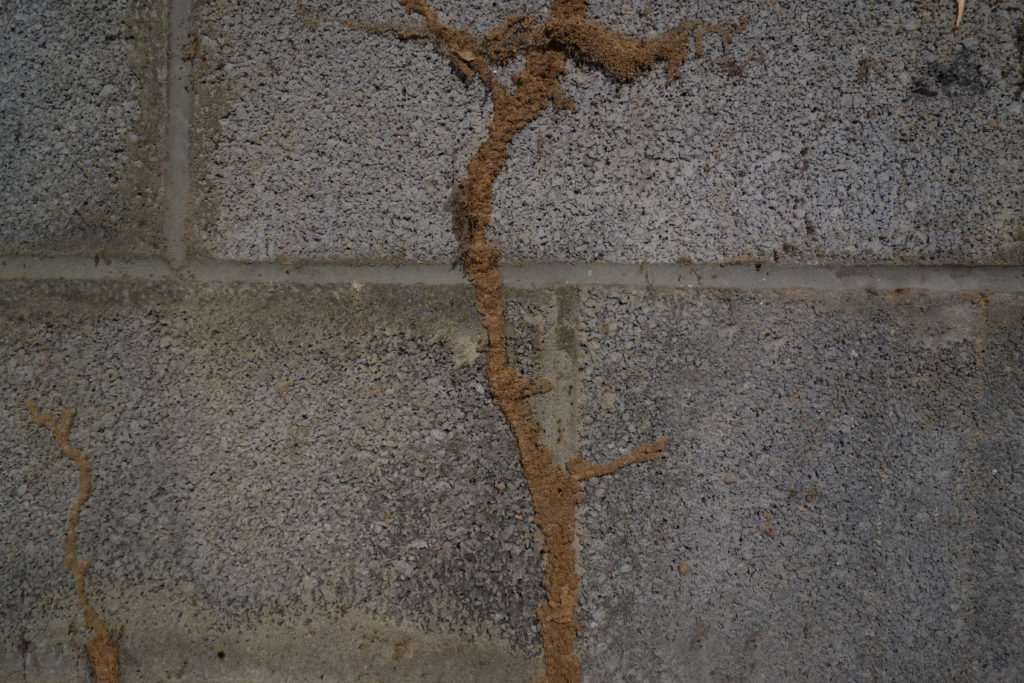
Termites use exploratory tubes to search for food sources.
They typically extend from the soil and are not connected to any wood.
Drop tube
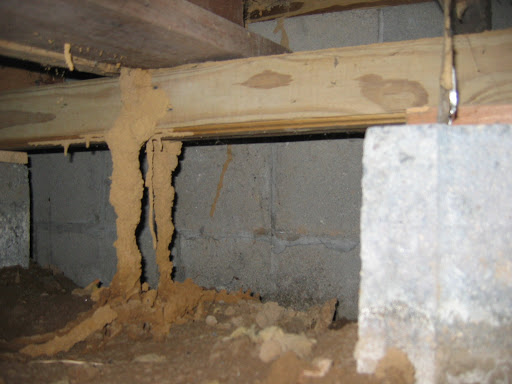
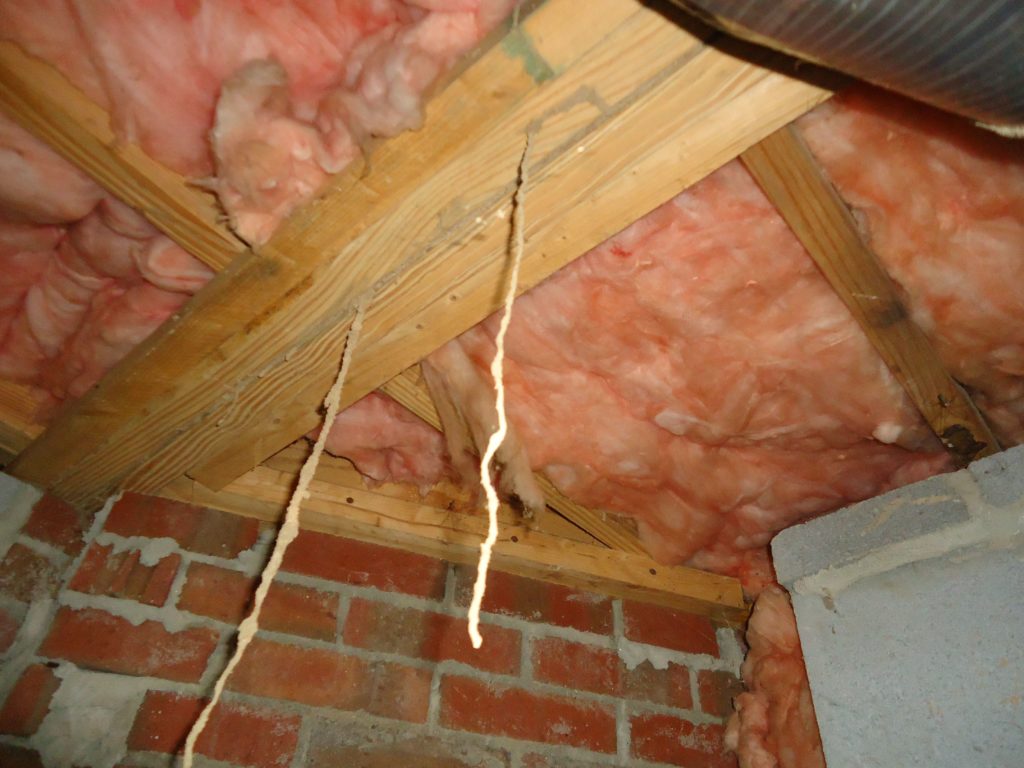
Drop tubes look like calcium deposits that hang in caves. Except they hang from the ceiling.
Subterranean termites use drop tubes to make food sources more accessible and to re-connect with working tubes and the ground.
Frequently Asked Questions (FAQ)
What is Termite Frass?
Termite Frass, also known as termite pellets, is a term used to describe termite droppings.
They are hexagonal and look a lot like coffee grounds mixed with sand.
But unlike sand, a drywood pellet has six concave surfaces.
They are hard, elongated, and less than 1/25 inch long.
They feel a little rough if stepped on.
How Do I Know if the Droppings Are Old or New?
For subterranean termite droppings, inspect if the mud tubes are empty.
Beak the tubes and inspect for any worker termites.
If it is, then the mud tubes are old and no longer being used by the termites.
For Damp wood termite droppings, peel the seal over the damaged wood to inspect for any termites.
If there are no termites, then they may be old droppings.
I recommend waiting several days to see if the termites repair the seal you broke.
If you come back and it is repaired, then you have an active infestation.
For Drywood termites pellets all moisture is removed. This means they don’t try up and get hard as time passes.
You can’t use color to tell if termite pellets are old.
Since the color depends on the wood they are eating, it is not a reliable way to determine how old droppings are.
The best way to determine if dropping are old or new is to clean them up.
Then monitor that location to see if they reappear.
If the pellets don’t reappear then its possible that they are old. And that the termites have moved on to a new area of the home.
If the pellets reappear after cleaning, then they are new and there is an active infestation in that location.
Are Termite Droppings and Poop Dangerous?
Termite waste is not in and of itself hazardous.
Unlike rats or cockroach feces, they do not carry disease-causing bacterias and pathogens.
How Do I Clean Up Droppings and Frass?
The easiest way to clean up pelletes and mud tubes is to vacuum them.
You may need to break down mud tubes a bit before vacuuming them to make it easier.
Mark sure to mark the areas before vacuuming.
Droppings are key signs of an active infestation.
Marking their location will help you track and treat the termites later.
Does the Appearance of Droppings and Frass Always Mean There Are Termites?
Droppings are not always a sign that there are nearby.
But it is a sign that there is an infestation in your home.
Unless you have had your home treated, it is likely the termites have moved to another location in your house.
Can Termite Droppings Fall from the Ceiling?
Yes. This happens more often that you would expect.
Drywood termites infest attics and the wood in your ceiling regularly.
If Drywood termites have infested your ceiling it is possible that they will create-kickout hole on the ceiling.
How Do Termites Use their droppings?
Termites use their droppings for both protection and navigation.
Subterranean Termite, for instance, creates mud tubes with their feces, saliva, and dirt.
They use these tubes to travel safely between a food source and the nest.
Dampwood termites, on the other hand, use their fecal pellets to protect their home.
This protection often looks like wood-colored stucco covering damaged wood.
Where Do You Normally Find Termite Droppings?
You’ll find Subterranean termites’ droppings near on or near soil.
As such, you can expect to find them near your pipes, in your attic, crawlspace, or along your foundation.
If you have a Drywood infestation, you may find small piles of Drywood termite pellets on your baseboards, floorboards, furniture legs, and under your furniture.
You may also find them around joists, beams, and joints inside attics and basements.
If you have wooded patriots or decks, check the corners and the base of the wood.
Finally, you’ll see Dampwood termites pellets near water or moist areas.
Some familiar places they’ll invest in your home is your basement, shed, deck, porch, and outdoor furniture.
You may also find them under sinks, tubs, or near water hoses.
Why does sand or sawdust suddenly appear in my home?
Drywood termite droppings are often confused with sawdust or sand.
It’s especially difficult to distinguish them if the termites have been feeding on light-colored wood.
If you are not sure where the dust is coming from, they are likely coming from termites.
To be sure, look for kick-out holes.
These are small holes in the wood near the sand or sawdust.
If you find the hole, this is a location where termites have infested your home.
